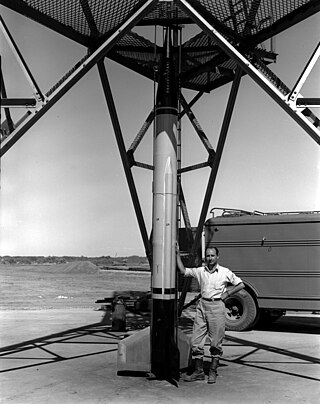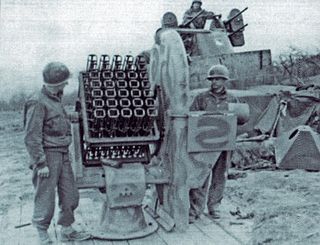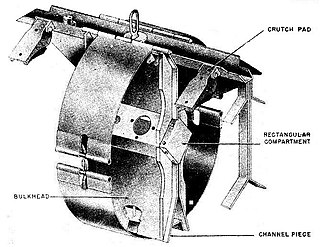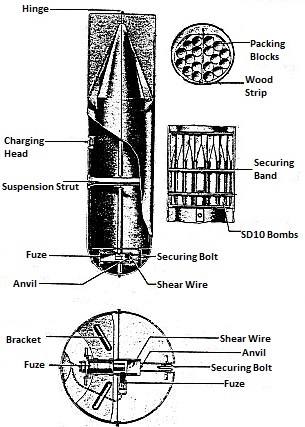
The Jupiter-C was an American research and development vehicle developed from the Jupiter-A. Jupiter-C was used for three uncrewed sub-orbital spaceflights in 1956 and 1957 to test re-entry nosecones that were later to be deployed on the more advanced PGM-19 Jupiter mobile missile. The recovered nosecone was displayed in the Oval Office as part of President Dwight D. Eisenhower's televised speech on November 7, 1957.

The Mk 153 Shoulder-Launched Multipurpose Assault Weapon (SMAW) is a smoothbore shoulder-fired rocket launcher. It is a portable assault weapon and has a secondary anti-armor ability. Developed from the B-300, it was introduced to United States Armed Forces in 1984. It has a maximum effective range of 500 metres (550 yd) against a tank-sized target.

The PGM-19 Jupiter was the first nuclear armed, medium-range ballistic missile (MRBM) of the United States Air Force (USAF). It was a liquid-propellant rocket using RP-1 fuel and LOX oxidizer, with a single Rocketdyne LR79-NA rocket engine producing 667 kilonewtons (150,000 lbf) of thrust. It was armed with the 1.44 megatons of TNT (6.0 PJ) W49 nuclear warhead. The prime contractor was the Chrysler Corporation.
Explorer 2 was an American unmanned space mission within the Explorer program. Intended to be a repetition of the previous Explorer 1 mission, which placed a satellite into medium Earth orbit, the spacecraft was unable to reach orbit due to a failure in the launch vehicle during launch.

The WAC Corporal was the first sounding rocket developed in the United States and the first vehicle to achieve hypersonic speeds. It was an offshoot of the Corporal program, that was started by a partnership between the United States Army Ordnance Corps and the California Institute of Technology in June 1944 with the ultimate goal of developing a military ballistic missile.

The RTV-A-2 Hiroc was a product of the United States' first effort to develop an intercontinental ballistic missile (ICBM). The project was named MX-774. The project was canceled in 1947, but leftover funds were used to build and launch three of the planned 10 research vehicles designated RTV-A-2. The design included several innovations; the gimbaled thrust chambers provided guidance control, the internal gas pressure was used to support the airframe and the nose cap was separable. All of these concepts were later used on the Atlas missile and the first two on the Viking rocket. Also developed as part of MX-774 was the Azusa guidance system which was not used on the Hiroc missile but did contribute to the Atlas missile as well as many other early guided missiles launched from Cape Canveral.

Explorer 5 was a United States satellite with a mass of 17.43 kg (38.4 lb). It was the last of the original series of Explorer satellites built, designed, and operated by the Jet Propulsion Laboratory.

Red Dean, a rainbow code name, was a large air-to-air missile developed for the Royal Air Force during the 1950s. Originally planned to use an active radar seeker to offer all-aspect performance and true fire-and-forget engagements, the valve-based electronics demanded a missile of prodigious size.

The SC 250 was an air-dropped general purpose high-explosive bomb built by Germany during World War II and used extensively during that period. It could be carried by almost all German bomber aircraft, and was used to notable effect by the Junkers Ju 87 Stuka. The bomb's weight was about 250 kg, from which its designation was derived.

The Henschel Hs 297 Föhn or 7.3 cm Raketen Sprenggranate was a small German surface-to-air rocket of the Second World War. The associated multiple rocket launcher was known as the 7.3 cm Föhn-Gerät.

Throughout World War II, both the Axis and Allied sides used propaganda to sway the opinions of Indian civilians and troops, while at the same time Indian nationalists applied propaganda both within and outside India to promote the cause of Indian independence.

Vanguard SLV-1, also called Vanguard Satellite Launch Vehicle-1 was hoped to be the second successful flight of the American Vanguard rocket following the successful launch of the Vanguard 1 satellite on rocket Vanguard TV-4 in March 1958.

The Type 10 and Type 3 rocket boosters were rocket artillery systems used by garrison troops of the Imperial Japanese Navy during the late stages of World War II in defense of island bases in the Pacific.

The Stielgranate 42 was a German fin-stabilized demolition charge, used with the 15 cm SIG 33 heavy infantry gun and armored vehicles armed with the SIG 33 during World War II. The primary purpose of the Stielgranate 42 was the demolition of concrete fortifications and for the clearing of minefields and barbed wire. Unlike the Stielgranate 41 it was not a shaped charge anti-tank weapon. In an emergency, the Stielgranate 42 could be used in an anti-tank role to great effect but due to its short range and poor accuracy the gun crew would be dangerously exposed to enemy fire.

The AB 250-2(Abwurfbehälter) was a cluster bomb used by the Luftwaffe during World War II.

The BDC 10 was a cluster bomb used by the Luftwaffe during World War II.

The AB 500-3A(Abwurfbehälter) was a cluster bomb used by the Luftwaffe during World War II.

The AB 500-1B(Abwurfbehälter) was a cluster bomb used by the Luftwaffe during World War II.

The AB 500-1(Abwurfbehälter) was a cluster bomb used by the Luftwaffe during World War II.

The 45 cm naval rocket was a rocket artillery system used by garrison troops of the Imperial Japanese Navy during the late stages of World War II in defense of island bases in the Pacific.
This page is based on this
Wikipedia article Text is available under the
CC BY-SA 4.0 license; additional terms may apply.
Images, videos and audio are available under their respective licenses.




















